#Ogaden
Explore tagged Tumblr posts
Text
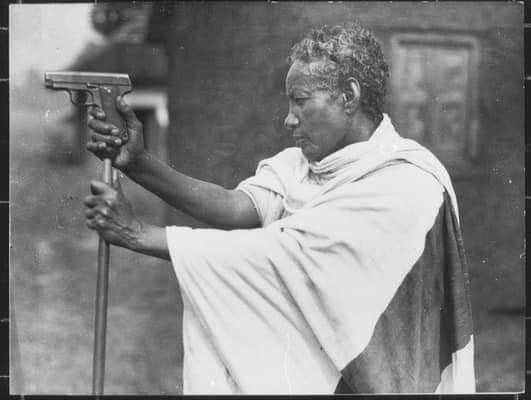
Abyssinian woman of 60 who killed 50 Italians at Adowa will fight again . Farlenekh , and old Abyssinian woman who fought in the battle of Adowa and saw Italy crushingly defeated 40 years ago , has asked Emperor haile Selassie for a mule and a rifle so that she can again fight the Italians in the Ogaden . 26 September 1935, Addis Ababa Ethiopia
#Addis Ababa#Ethiopia#Ogaden#War#Hero#Warrior#African#Battle of Adowa#Italy#Emperor Haile Selassie#Boss
159 notes
·
View notes
Text
Armored casualties of the Ogaden War including Soviet-made T-34/85 and US-made M47 and M60A1 tanks in Eastern Ethiopia late 1977
#ogaden war#cold war#t-34#m47 patton#m60#tanks#russian armor#russian tanks#american armor#american tanks
17 notes
·
View notes
Text
To wrap up today, the start of Somalia's long catastrophe begins here:
The war in the Ogaden was the starting gun on the subsequent collapse of Somalia into an anarchistic den of warlords, and on the future history of warfare with the post-monarchical Ethiopian regime waging multiple brutal wars with Eritrea. For Ethiopia, too, the long sequence of monarchies going back to ancient Aksum to the present finally and bluntly came to an end with a Marxist putsch against the same Hailie Selassie deposed by the other 20th Century 'paradise over a bridge of corpses' extremists. The US in turn backed General Siad Biarre, whose overthrow in the 1990s would lead to one of the forgotten wars the US waged in Somalia.
The result was that at the Battle of Harar the Soviet-backed Derg regime defeated the US-backed Biarre regime, providing one of the many reasons why the ultimate disintegration of the USSR blindsided so many people in and out of the USSR. Globally, outwardly, the USSR looked like it was winning, not losing, the Cold War.
#lightdancer comments on history#black history month#african history#world history#military history#cold war in africa#ogaden war
0 notes
Text
FIDEL CASTRO: MAN OF THE MASSES IN AFRICA
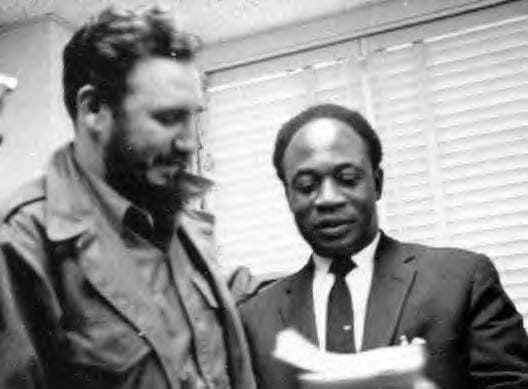
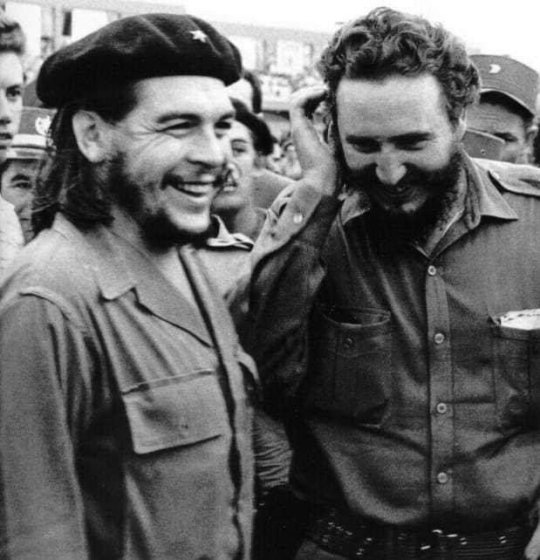
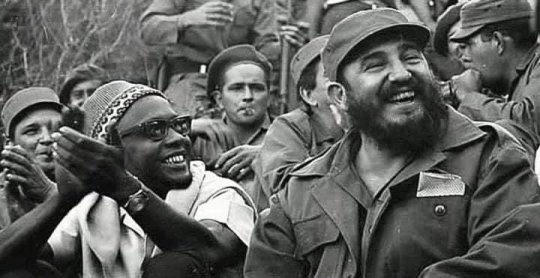

In the 1970s and 80s, Fidel Castro sent 350,000 Cuban soldiers, civilians and doctors to support the African liberation struggle, especially in Angola 🇦🇴 , Namibia, Mozambique 🇲🇿 , Guinea Bissau , Cape Verde 🇨🇻 , and Sao Tome and Principal 🇸🇹 . The Cuban effort eventually hastened the demise of apartheid in South Africa. More than 3,000 Cubans died fighting for Africa.
After the Cuban and their Angolan, Namibian and ANC allies decisively defeated the then feared South African defence forces in Angola, it brought independence not only to Angola and Namibia, but also accelerated the death of apartheid itself in South Africa.
About 600 Cuban soldiers, including 70 doctors, went to Guinea Bissau to help the African guerrillas for 10 years before “independence” from the Portuguese came in 1974. Cuba fought in Ethiopia on the side of Colonel Mengistu Haile Miriam’s troops in the Ogaden campaign in 1978 against an invasion by Somalia. In 1965, Cuba sent the legendary Che Guevara and fighters to Kibamba, near Fizi, in DRCongo’s province of South Kivu, to help the supporters of Patrice Lumumba.
Then came Mozambique and Angola where the biggest Cuban action in Africa was staged against apartheid South African troops backed by America and its Western allies. Castro takes up the story in his memoirs: “ While Cuba was in Angola, and Angola was being invaded by South Africa, the USA made arrangements to transfer to South Africa–racist, fascist South Africa–several atomic bombs, similar to those it exploded in Hiroshima and Nagasaki.”
16 notes
·
View notes
Text
Alcohol smuggler Guled Diriye is exhausted.
He has just returned from his trip transporting contraband from the Ethiopian border.
The 29-year-old slumps in his chair inside a colonial-style villa battered by years of fighting in Somalia’s capital, Mogadishu - a city once known as the Pearl of the Indian Ocean.
His sandals are covered in a potent orange dust – the residue from the desert.
Mr Diriye’s dark eyes droop. The bags underneath speak of sleepless nights, the hours of tension traversing the dangerous roads and negotiating checkpoints with armed men.
There is also the haunting memory of a fellow smuggler who was shot dead.
“In this country, everyone is struggling and looking for a way out. And I found my way by making regular trips by road from the Ethiopian border to Mogadishu,” he says, explaining that smuggling was a means to support his family in a tough economic climate.
The use and distribution of alcohol is illegal. Somalia’s laws must comply with Sharia (Islamic law), which forbids alcohol, but it has not stopped a growing demand, particularly among young people in many parts of the country.
Mr Diriye’s neighbour Abshir, knowing he had fallen on hard times as a minibus-taxi driver, introduced him to the precarious world of alcohol smuggling.
Rickshaws began to take over the city, pushing minibus drivers out of business.
Both were childhood friends who had sheltered together in the same camp in 2009 during the height of the insurgency in Mogadishu - he was someone he could trust.
“I began picking up boxes of alcohol at designated drop points in Mogadishu on [his] behalf and manoeuvring through the city and offloading them at designated locations. I didn’t realise it at first but this was my introduction into smuggling.”
His involvement snowballed and Mr Diriye soon found himself navigating from the porous frontier with Ethiopia through Somalia’s rural hinterlands.
He understands that he is breaking the law, but says the poverty that he finds himself in overrides that.
The smuggling journey begins in Somali border towns such as Abudwak, Balanbale, Feerfeer and Galdogob.
“Alcohol mostly originates in [Ethiopia’s capital] Addis Ababa and makes it to the city of Jigjiga, in the Ogaden region,” Mr Diriye says.
The Ogaden or, as it is officially known in Ethiopia, the Somali region, shares a 1,600km (990-mile) border with Somalia. People on both sides share ethnic, cultural, linguistic and religious ties.
Once the alcohol is loaded, it is moved across the plains of the Somali region, and then smuggled across the border into Somalia.
The border town of Galdogob is a major hub for trade and travel and has been hit hard by the flow of alcohol being smuggled from Ethiopia.
Tribal elders have raised concerns over alcohol-related violence.
“Alcohol causes so many evils [such as shootings],” says Sheikh Abdalla Mohamed Ali, the chairman of the local tribal council in the town.
“[It] has been seized and destroyed on multiple occasions but it's like living next to a factory. It keeps putting out more and more, no matter what we do.”
“Our town will always be in the midst of danger.”
But for the smugglers the goal is to get the alcohol to the capital.
“I drive a truck that transports vegetables, potatoes and other food products. When the truck is loaded up it’s filled with whatever I'm transporting, but I make the most money from the alcohol on board,” Mr Diriye says.
Sometimes smugglers cross into Ethiopia to pick it up and at other times they receive it at the border. But whichever approach is taken, concealment is a crucial part of the profession as the risks from being caught are immense.
“The loader’s job is the most important. Even more important than driving. He’s tasked with concealing the alcohol in our truck, with whatever we have on board. Without him, I wouldn’t be able to move around so easily — at least not without getting caught.
“The average box of alcohol I move has 12 bottles. I usually transport anywhere from 50 to 70 boxes per trip. Usually half the load on my truck is filled with alcohol.”
Large swathes of south-central Somalia are run by armed groups, where the government has little to no control: militias, bandits and the al-Qaeda affiliate al-Shabab roam with impunity.
“You can never travel on your own. It's too risky. Death is always on our minds,” Mr Diriye says. But that concern does not get in the way of business and there is a brutal pragmatism to thinking about the make-up of the team.
“If I get wounded in an attack on the road, there has to be a back-up who can continue the journey. Everyone knows how to drive and knows the roads well.”
Smugglers drive on dirt tracks and roads that have not been renovated in decades. Landmines and unexploded ordnances left behind from previous conflicts are also an issue.
“I travel through at least eight to 10 towns to reach Mogadishu. But we don’t count the towns, we count the checkpoints and who mans them,” Mr Diriye says.
They encounter various clan militias with different allegiances, either lingering in the distance or at roadblocks.
“In case we get jammed up by a clan militia, if one of us is from the same clan as that militia or even a similar sub-clan, it increases our chances of survival. This is why all three of us are from different clans.”
He painfully recalls: “I’ve encountered numerous attacks.
“One of the guys that works with me is relatively new. He replaced my last helper who was killed two years ago.”
Mr Diriye had been driving in suffocating heat for six hours, so decided to nap, passing the wheel to his helper.
“While I was sleeping in the back, I heard a large burst of gunfire that suddenly woke me up. We where surrounded by militiamen. My loader was screaming as he ducked in the passenger seat.” The substitute driver was killed.
Once the commotion ceased, the loader and Mr Diriye picked up their dead colleague from the front seat and put him in the back of the truck.
“I’ve never seen so much blood in my life. I had to wipe [it] away from the steering wheel and keep on driving. In all my years, nothing prepared me for what I saw that day.”
As the pair drove off and got a good distance away from the militiamen, they pulled over to the side of the road and laid his body there.
“We didn’t even have a sheet to cover his body, so I took off my long-sleeved buttoned-up shirt and made do with it.
“It was a difficult decision but I knew I couldn't keep driving around smuggling alcohol with a dead body in the truck. We had a few government checkpoints up ahead and I couldn’t jeopardise my load or my freedom.”
Two years later he says the guilt of leaving the body by the road still haunts him.
He left behind a family, and Mr Diriye is unsure they even know the truth surrounding the circumstances of his disappearance and death.
The danger that Mr Diriye faces is a recurring reality that many smugglers endure while illicitly ferrying alcohol from Ethiopia to Mogadishu, in order to quench the growing demand.
Dahir Barre, 41 has a slim build with noticeable scars on his face that appear to tell a story on their own. He has a dark sense of humour and seems hardened by the near-decade of smuggling that enables him to bypass the possible consequences of what he does.
“We face a lot of problems and dangers but still continue to drive despite the risk due to the poor living conditions in Somalia,” he says.
Mr Barre has been smuggling alcohol from Ethiopia since 2015 and says lack of opportunity made worse by years of poverty pushed him into the dangerous trade.
“I used to do security for a hotel in the city centre. I was armed with an AK-47 and was tasked with patting people down at the entrance.”
Long nights in a dangerous job with meagre pay did not feel worth it.
“One hundred dollars a month to stand in the way of potential car bombs that might plough through the front entrance sounds crazy now that I think of it.”
One of the day-shift guards then put him in touch with friends from the border region and “I’ve been travelling these roads ever since”.
“Back in 2015 I was only getting $150 per trip, compared to $350 per trip now and those days it was far riskier because al-Shabab had control over more territory, so you risked more encounters with them.
“Even the bandits and militias were more dangerous back then.
“If you had red or brown stained teeth, the militias would assume you chewed khat and smoked cigarettes, meaning you had money so they would abduct you and hold you for ransom.
“As drivers we’ve been through a lot and the danger still exists,” Mr Barre says.
If they are caught by al-Shabab fighters then it can be most dangerous since the armed group has a zero-tolerance policy on contraband, especially alcohol. The Islamist insurgents set the vehicle on fire and then detain the smugglers before fining them.
Other armed men can be more easily bribed with money or liquor.
It takes an average of seven to nine days to reach Mogadishu from the Ethiopian border. The smugglers then make their way to a pre-arranged drop-off point.
“When we arrive, a group of men will show up and unload the regular food products into a separate truck, then leave. Afterwards, once that’s done, another individual will arrive, sometimes accompanied by more than one vehicle and they’ll take the boxes of alcohol,” Mr Diriye says.
“But it doesn’t end there. Once it leaves my possession, it’ll pass through more hands, eventually ending up with local dealers in the city, who can be reached with a simple phone call.”
Mr Diriye often thinks about his entry into smuggling, and where his future may lie.
“My neighbour Abshir who initially got me into smuggling alcohol, stopped doing it himself three years ago.”
Abshir offered his nephew, an unemployed graduate at the time, a job in smuggling. But he was killed on his third trip in an ambush by bandits.
“Afterwards Abshir quit smuggling. He became religious and turned to God. I rarely see him any more.”
Despite the dangers, Mr Diriye says it will not deter him.
"Death is something that is predestined. I can't let fear come in the way of making a living. Sure, sometimes I want to throw the keys on the table and start afresh but it's not that easy. Temptation is everywhere and so is poverty."
All names have been changed in this story.
4 notes
·
View notes
Text
There is no available record of when exactly Nur Omar Mohamed was in active service. He was almost certainly involved in the Ogaden invasion of Ethiopia and the 1982 Ethiopian invasion of Somalia.
It is more questionable his degree of direct culpability for the Isxaaqi genocide, which was carried out by rival clan militias armed and encouraged by the Mohamed Ziyad Barre government. Senior officer positions in dictatorships can be cushy rewards for regime supporters and family members of the autocrat. Many used their rank to avoid danger and potential harm. He need not have been called to the or even worn a uniform by then. Then again, the regime at all levels was guilty of its crimes against humanity, and even in an administrative capacity Col. Nur would thus have assisted in the slaughter.
What cannot be questioned is that the family were elites in Mohamed Ziyad Barre’s government. They were not just commoners caught haplessly in the violence that replaced a brutal dictatorship with brutal warlords and brutal anarchy; they were well placed members of the regime, who fled being called to account for the human rights abuses carried out in the name of their comfortable lifestyles. They were closer to Miami Batististas than to the desperate, homeless refugees of popular imagination. Rep. Ilhan admired her father and had fond memories of the childhood she spent in such privilege. It does make me how much she prefers those memories to the pluralistic, deliberative, representative and consensual body in which she now serves.
5 notes
·
View notes
Text
In the Napoleonic wars, for every French soldier killed, roughly 0.4 civilians were killed.
In WW1, for every soldier killed by the central powers, roughly 0.7 civilians were killed.
In the Ogaden war, for every soldier killed, roughly 2 civilians were killed.
In WW2, for every soldier killed by the Axis, roughly 3 civilians were killed.
In the gulf war, for every Kuwait soldier killed, roughly 4 civilians were killed.
Since October, in the Israeli-Hamas conflict, for every Hamas soldier killed, roughly 20 civilians have been killed.
This is not the necessary cost of war. This is, at best, gross and sickening neglect, and at worst, intentional genocide.
I don’t think October 7th was justified, but the response to it is no more so. It hasn’t been for a few months at the least.
5 notes
·
View notes
Text

Soldado del Frente de Liberación de Somalia Occidental de pie sobre una estatua del León Imperial de Etiopía en Qalaafe liberado durante la Guerra de Ogaden (1977
3 notes
·
View notes
Text
Setting Blurb: MacroCommunity Greater Somalia

The Somali Civil War reignited with the outbreak of the Third World War, with the breakaway East African Federation-backed Mogadishu government reasserting their claims over the breakaway Somaliland. The conflict spilled over into the Somali-speaking Ogaden in Ethiopia and Djibouti, and financial and military aid from the African Union and Arab League diminished as WWIII took its toll globally. The collapse of the United States and China caused a global wave of economic, political, and then societal collapse. The East African Federation withdrew from Somalia to maintain some semblance of stability on the home front, and the Mogadishu and Hargesia governments broke.
The generation of conflict that followed, known as the "Warlords' Wars", would see the emergence of protostates filling the vacuum created by the anti-climactic end of WWIII. Somalia's clans were quick to reassert themselves, and spent the Warlords period fighting for influence and territory. As the wars died down globally, a successor state to the Ethiopian government emerged to challenge the Somali clans of the Ogaden for control of the territory.
It was during this time that a growing alliance of warlords in the former United States, European Union, and China began approaching the remnants of ECOWAS and the East African Community to serve as springboards into incorporating the rest of the African continent. Fearing the new Ogaden War's potential spillover into eastern and central Africa resulted in a series of talks and border skirmishes that made Ethiopia and Somalia EAC protectorates (which was itself annexed into the Imperial League). Somalia retained the Ogaden (and Somali-majority areas in Kenya), and Ethiopia was placated with the annexation of Eritrea and non-Somali Djibouti.
The Eight Gobols: These eight provinces are the territory held by the extant clans and sub-clans that survived the Warlords' Wars period. The clans' territorial holdings were formally recognized by the early League government, and their leadership awarded collective governorship over the new MacroCommunity. Each Gobol is governed by a Xeer court, which oversees vocational councils (professions within the clan are held by one or more sub-clans) and maintains the clan militia.
Gosha Kaunti: The de facto capitol region of Greater Somalia, Gosha Kaunti is named for Somalia's Bantu-speaking minority. The Gosha have risen in prominence due to serving mediators for the clans around them (as their ancestors were not formally incorporated into the Somali clan system) should the Xeer courts be found unsatisfactory. The MacroCommunal governor's personal guards and a small detachment of Support Service Force security troopers help ensure that the clans find Gosha mediation to be more than satisfactory.
Land Force Demesne Djibouti: Carved out of the Somali speaking partition of Djibouti, this Land Force Demesne houses the East African third of Field Army Yellow's naval assets. Piracy still plagues the horn of Africa, with many in the Imperial Armed Forces believing that the pirates are receiving aid from the League's rivals.
3 notes
·
View notes
Text
The Politics of Transition and Succession in Jubaland
Uncertainity grips #Jubaland as reports of Madoobe's poor health spark succession debate. With over a decade at the helm, His potential exit raises questions about clan dynamics, federal influence & regional elections. A peaceful transition is no guarantee. #Somalia
Continue reading The Politics of Transition and Succession in Jubaland
#Al-Shabaab#Axmed Madoobe#Federal Member States (FMS)#Hassan Sheikh Mohamud#Jubaland#Kismayo#Marehan#Mohamed Abdullahi Farmajo#Ogaden#Sahan Research#Somali Wire#Somalia
0 notes
Text
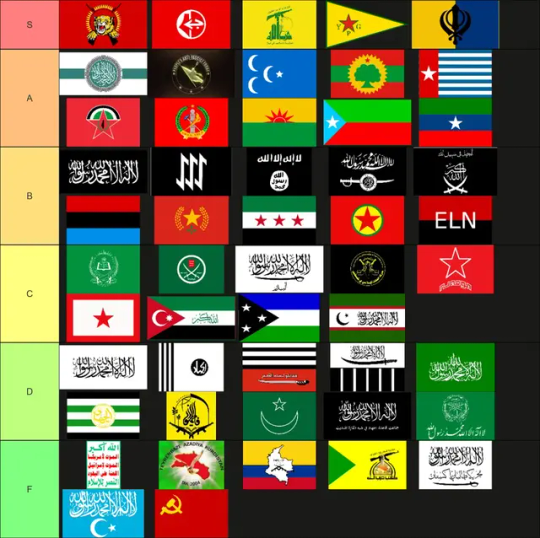
The official tier list of globally recognized terrorist organizations based off of their flag designs
This is 100% scientific fact based off of my personal research into the field of vexillology. Argue with me if you want to in the comments. There groups in order from left to right are: (S): Liberation Tigers of Tamil Eelam, Popular Front for the Liberation of Palestine, Hezbollah, People's Defense Units, Khalistan Liberation Force (A): Hayʼat Tahrir al-Sham, People's Anti-Fascist Front, Great Eastern Islamic Raiders' Front, Oromo Liberation Front, Free Papua Movement, Democratic Front for the Liberation of Palestine, Tigray People's Liberation Front, United Liberation Front of Asom, Balochistan Liberation Army, Ogaden National Liberation Front (B): Al-Qaeda, The Base, Daesh, Hurras al-Din, Congress of the Peoples of Ichkeria and Dagestan, Lord's Resistance Army, People's Liberation Army of Manipur, Syrian Revolution, Kurdistan Workers' Party, National Liberation Army (Colombia) (C): Jamiat-e Islami, Muslim Brotherhood, Al-Badr, Palestinian Islamic Jihad, Komala Party of Iranian Kurdistan, United National Liberation Front, National Liberation Movement of Ahwaz, Kamtapur Liberation Organisation, Islamic Renaissance Party of Tajikistan (D): Taliban, Jaish-e-Mohammed, Lashkar-e-Jhangvi, Lashkar-e-Taiba, Hamas, Harkat-ul-Mujahideen, Liwa Fatemiyoun, Dukhtaran-e-Millat, al-Qaeda in the Indian subcontinent, Hezb-e Islami Gulbuddin (F): Houthi, Kurdistan Freedom Hawks, Revolutionary Armed Forces of Colombia, Kata'ib Hezbollah, Tehreek-i-Taliban, Turkistan Islamic Party, Shining Path
29 notes
·
View notes
Text
Nolol har iyo habeen kala dooraneeysid jiro iyo gaajo
A life in which every day and night, you have to choose between sickness and hunger
- Maxbus nr 77 by Bile M Hashi
#somalia#somali#somali literature#somali poetry#somali art#somali history#somali culture#somali quotes#somali quote#somali books#Bile M Hashi#Maxbus nr 77#prisoner nr 77#fiction#Ogaden war
0 notes
Text
youtube

Release: May 3, 1985
Lyrics:
I'm hearing only bad news from Radio Africa
Hearing only sad news from Radio Africa
I'm hearing only bad news from Radio Africa
They've still got trouble with a monster in the South
Heads buried deep in that lion's mouth
Like a jaw snapped shut, it keeps them apart
If that jaw got broken it would be a start
I'm hearing only sad news from Radio Africa
The West still complains about the foreign aid
They'd do better to change the terms of the trade
There's more tanks than food in the Ogaden
It looks like Moscow got it wrong again
I'm hearing only bad news from Radio Africa
I'm hearing only sad news from Radio Africa
I'm hearing only bad news from Radio Africa
I'm hearing only sad news
Mozambique and Mugabe
Still got FRELIMO I hear them say
But exchange means
Recession means
It all means it's harder to take
Tanzania could be moving up a gear
Instead they've got to step on the brake
I'm hearing only bad news (so many movements have come this far)
I'm hearing only bad news (the lending means and interest means it's harder to find)
I'm hearing only bad news from Radio Africa (independence has a hidden expense)
I'm hearing only bad news from Radio Africa (when the hands of the purse strings are white)
Hearing only bad news from Radio Africa
Hearing only bad news from Radio Africa
Hearing only bad news from Radio Africa
Hearing only the bad news from Radio Africa
Hearing only the bad news from Radio Africa
Songwriter:
Michael Carlos Jones / Ronald Keefe / Stephen Robert Skaith
BandFacts:
👉📖
Homepage:
Latin Quarter
#new#my chaos radio#Latin Quarter#Radio Africa#music#spotify#youtube#music video#youtube video#good music#hit of the day#video of the day#80s#80s music#80s nostalgia#80s video#80s charts#1985#pop#rock#alternative indie#folk#ballad#world & country#reggae#indie rock#reggae pop#lyrics#songfacts#2968
0 notes
Text
The Unsung Heroes: Somali Republic Military Officers in the 1977 Ogaden War
In the annals of military history, few conflicts have captured the imagination and admiration of strategists as much as the 1977 Ogaden War between Somalia and Ethiopia. This conflict was not just a territorial dispute but a testament to the courage, strategic brilliance, and unwavering dedication of the Somali National Army (SNA) officers who fought for their people's cause. In this blog, we delve into the lives and achievements of these remarkable officers, whose stories deserve to be told.
A Nation United by Language, Divided by Maps
The quote by Salman Rushdie—"To be Somali is to be a people united by one language and divided by maps"—resonates deeply with the context of the Ogaden War. For the Somali people, the war was more than a political endeavor; it was a just cause aimed at uniting ethnic Somalis under one banner. However, the international community viewed it through the lens of irredentism, complicating Somalia’s diplomatic and military efforts.
Despite these challenges, the Somali military leadership demonstrated exceptional skill and resilience. The war effort was spearheaded by General Mohamed Ali Samatar, ably supported by Chief of National Army Staff General Abdullahi Fadil, Deputy Chief Colonel Ahmed Hassan Muse, and other distinguished officers. Their collective expertise and commitment were instrumental in executing one of the most sophisticated military campaigns on the African continent.
Command Structure and Key Figures
The Somali National Army was organized into two main command centers: the North Command based in Hargeisa and the Southern Command based in Baidoa/Mogadishu. Each command center oversaw various divisions and directorates crucial to the war effort.
North Command : Led by notable figures such as Colonel Yussuf Salhan, who commanded the Jigjiga Center, and Colonel Farah Handulle, who successfully captured Wardheer. These leaders, along with their deputies, orchestrated complex operations that resulted in significant victories.
Southern Command : Included prominent leaders like Colonel Abdullahi Yussuf, who led the Negheille Center, and Colonel Abdullahi Irro, responsible for the Godey Center. Their strategic acumen and leadership ensured the success of multiple fronts.
Notable Battles and Heroes
Several battles stand out in the narrative of the Ogaden War, each marked by the valor and tactical prowess of Somali officers.
Godey Campaign : Launched on July 13, this surprise attack set the stage for subsequent victories. Under the leadership of Colonel Abdullahi Irro and his deputy Major Abdulkadir Kosar, the Somali forces swiftly secured Godey, paving the way for further advances.
Qabri-Dahare Front : Commanded by Colonel Ali Hussein and his deputy Major Abdulaziz Bowbowleh, both graduates of the prestigious Frunze Military Academy. Their meticulous planning and execution led to the liberation of Qabri-Dahare within two days. Major Yassin Hurfe, another standout officer, played a pivotal role in the tank battalion support, ultimately sacrificing his life in the final hours of the battle.
Wardheer Victory : Colonel Farah Handulle and his deputy Major Mohamed Mahmood Sheikh achieved a remarkable feat by capturing Wardheer, where a large number of Ethiopian prisoners of war were taken. This victory underscored the effectiveness of the Somali national strategy.
Legacy and Aftermath
The legacy of these officers extends beyond the battlefield. Many continued to serve their nation in various capacities long after the war. For instance:
Colonel Ali Hussein became a revered figure in the Somali National Movement (SNM), contributing significantly to its reorganization in the late 1980s.
Major Abdulaziz Bowbowleh and Major Dahir Indha-Qarsho remained influential in northern fronts.
Colonel Farah Handulle , despite being tragically killed in 1987, left an indelible mark as a governor of several regions.
Several officers, including Generals Begedi, Aftooje, Aare, and Ali Ismail, served as military attachés in key countries, enhancing Somalia’s diplomatic relations.
Conclusion
The Somali Republic military officers of the 1977 Ogaden War exemplified the spirit of unity, bravery, and professionalism. Their contributions not only shaped the course of the conflict but also left a lasting impact on Somalia’s military and political landscape. As we reflect on their achievements, let us remember and honor these unsung heroes whose dedication and sacrifice continue to inspire generations.
0 notes
Text
Ethiopian Somali Regional Special Forces execute hundreds of Isaaq Community
#BREAKING: Ethiopian Somali Regional Special Forces Celebrate After Burning Entire Isaaq Community Villages and Killing Hundreds. The Somali regional state of Ethiopia has descended into a grim reality of ethnic violence under the leadership of its president, Mustafe Cagjar. In a chilling display of impunity, his regional special forces—composed entirely of individuals from Cagjar’s Ogaden…
0 notes
Text
Abyssinia are in the THICK OF IT
[Reuters] [10 Feb 1927]
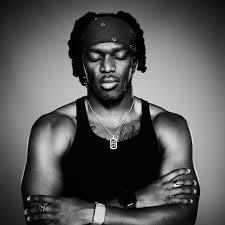
Above: An Abyssinian Warrior on the Ogaden front seen resigning to his fate
Despite Abyssinian efforts, the troops of Abyssinia in the Ogaden region have been grossly overpowered by Graziani's men from the southern front. It appears that the troops from both the southern and northern front are charging fiercely toward the capital of Addis Ababa.
However, support for Abyssinia has seemed to skyrocket over the African continent. Despite a lack of solid action taken, media throughout the African continent show stories of humanitarian disasters in Abyssinia.
0 notes